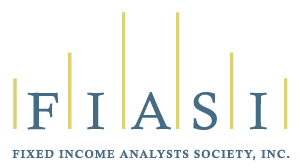Introduction of John C. Hull by John Finnerty
It is a great pleasure to be able to introduce Dr. John Hull, Professor of Derivatives and Risk Management and Co-Director of the Master of Finance Program at the Joseph L. Rotman School of Management at the University of Toronto.
John is an eminent scholar who rightfully belongs among the many other luminaries in FIASI's Hall of Fame.
John is an internationally recognized authority in the areas of fixed income modeling, derivatives, and risk management. He has written three books, including Options, Futures, and Other Derivatives, which is now in its seventh edition. It is a beautifully written and informative text that is a must-read for every fixed income professional with a keen interest in fixed income valuation.
As this book and his other writings make so abundantly clear, John has the unusual ability to explain and illustrate complex subjects in a way that makes them accessible to a broad range of fixed income professionals.
In the fixed income area, John is perhaps best known for co-developing the Hull-White interest rate model, for which he and Alan White won the Nikko-LOR research competition. John has won numerous teaching awards, and he was voted the Financial Engineer of the Year in 1999 by the International Association of Financial Engineers.
So it is my distinct pleasure to introduce Dr. John Hull.
John Hull's Remarks: Fixed Income Analysts Society Dinner, February 24 2009.
Thank you, John Finnerty, for introducing me. This is a great honor.
I would like to start by introducing my guests. The first is Roger Stein from Moody's. In 2001, Roger, together with Richard Cantor, who unfortunately could not be here for the dinner this evening, started something called the Moody's Academic Advisory and Research Committee. Roger and Richard were kind enough to ask me to be chairman of the committee. It consists of 7 to 10 academics who meet twice a year with Moody's own researchers to present research ideas and discuss areas of common interest. We have now had 14 meetings and five conferences have been organized. Three of the conferences were in New York and two in Europe. It has been a successful and exciting venture.
My second guest is Donna Battista, who is my editor at Pearson. It is hard to believe, but I am now working on my 15th book with Pearson, formerly Prentice Hall. I have three books and each one comes out in a new edition every 3 years. So that means one new book a year! Sometimes, authors are able to put a new cover on a book without changing it much and call it a new edition. Unfortunately, it has never worked that way for me. Derivatives markets and risk management practices change so fast that that my books have to be reworked with each new edition. Otherwise they would become out of date fast. The first edition of Options, Futures and Other Derivatives was written in 1987. It was a little more than 300 pages long with a big font size. The book is now in its 7th edition and is 800 pages long with a much smaller font size. My project for this academic year is the second edition of Risk Management and Financial Institutions. With the events of the last 20 months, the book has had to be largely rewritten. As you can imagine, there is now a much greater emphasis on liquidity risk and stress testing.
My final guest is Sean Rogister. Sean is a graduate from Rotman, University of Toronto's business school. He is a good friend of Rotman and a good friend of mine. He was until recently working in a senior position in fixed income at Ontario Teachers.
One thing I must admit to you is that, until I received this honor, I never really thought of myself as being in fixed income. If you had asked me about my area, I would have said "derivatives and risk management." But my research has evolved in three stages so that it is now closely aligned with fixed income. In the 1980s, my research was all about improving Black-Scholes and developing numerical procedures. Then, I was concerned with modeling a single number such as a stock price or an exchange rate. In the 1990s, I became interested in interest rate models . The problems were greater because I was interested in modeling a whole function, the term structure of interest rates, not a single variable. Toward to end of the 1990s, I moved on to credit risk models. Here, the problems are different again because there is a discrete event, default, that either happens or does not happen. This honor that you have given me is a sign of how different strands of research are coming together. Research ideas in fixed income, interest rate models, and credit risk models are becoming intertwined. I thank the selection committee for recognizing this.
One of the great things about doing research in my area is that the interests of researchers and practitioners are so close. Indeed, many practitioners are more academic in their approach to research than me! One thing I enjoy about my job more than anything else is speaking to practitioner groups and going to practitioner conferences. Most of my research ideas have come from interactions with practitioners, not academics.
One final observation. Nearly all my research publications have been joint with my long time friend and colleague Alan White, who unfortunately could not be here tonight. We have been working together now for over 25 years. He deserves this award as much as I do. Thank you.








